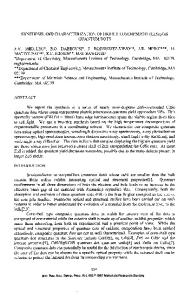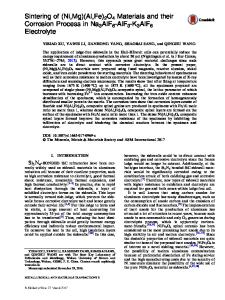Synthesis, characterization, and potential application of highly chemically durable glasses based on AlF 3
- PDF / 528,107 Bytes
- 6 Pages / 594 x 792 pts Page_size
- 49 Downloads / 281 Views
(Received 30 April 1990; accepted 10 October 1990) Fluorozirconate glasses are stable with respect to devitrification but have poor chemical durability and only fair mechanical strength. AlF3-based glasses with improved chemical durability and enhanced mechanical strength are reported here. The optical, mechanical, and thermal properties of these glasses are contrasted to the more familiar ZBLAN composition. The infrared edge of these glasses lies at shorter wavelengths than ZrF4-based glasses, but aluminum fluoride glasses offer some interesting opportunities for short-range IR fiber applications such as sensing, remote spectroscopy, and laser power propagation.
I. INTRODUCTION
In recent years there has been growing interest in the study of fluoride glasses.1"5 Due to their middle infrared region transparency and very low theoretical loss ZrF3OH + H + 3 O (3) The second stage is a diffusion-controlled process in which OH" ions from the solution diffuse through the surface layer from the precursor stage and then corrode the inner glass.17 The third and the final step is the crystal-blocking period. The dissolution rate decreases rapidly, the composition of the glass surface deviates from the original composition, and a lot of F~ and OH~ ions are formed. In the dynamic corrosion experiments the solution containing the sample is continuously stirred and the fluoride ion concentrations are monitored with the fluoride ion selective electrode. Dynamic water corrosion also takes place in three different steps. First, the glass surface begins to corrode widely, which is followed by
which contains a large percentage of heavier atoms such as Th, the IR transmission extends to 7.1 C. Chemical durability
It is generally observed that introduction of water in HMF glass yields a strong band at 3450 cm' 1 (2.9 ^,m) assigned to the stretch mode of OH" resulting from hydrolysis, as given by Eq. (1), and a weaker one at 1600 c m 1 (6.2 ju,m), due to the bend mode of the water.15 (1) F"(c) + H2O(g) -* OH-(c) + HF(g) where (c) = condensed and (g) = gas. Two different types of corrosion conditions (static or dynamic) may occur when a fluoride glass reacts with the water. During the static corrosion the glass samples are suspended into the distilled water, which is continuously changed and analyzed after regular intervals of time.16 The static corrosion takes place in three
2
4
6
WAVELENGTH
8
10
12
(urn)
FIG. 3. Absorption spectra of 4 mm disks of different glass systems. The optical density scale is correct for ZBLAN (ZrF 4 -BaF 2 LaF 3 -AlF 3 -NaF) glass, and the other three spectra have been displaced upward for comparison.
J. Mater. Res., Vol. 6, No. 2, Feb 1991
403
T. Iqbal et a/.: Synthesis, characterization, and potential application of highly chemically durable glasses
z, o CO
GO
z 2
WAVELENGTH
4
6
WAVELENGTH
(|im)
(|im)
FIG. 4. IR spectra of 4 mm disk of ABCYS (AlF 3 -BaF 2 -CaF 2 YF3-SrF2) glass: (A) as-polished; (B) after 24 h in de-ionized water.
FIG. 6. IR spectra of 4 mm disk of BATY (BaF2-AlFi
Data Loading...











